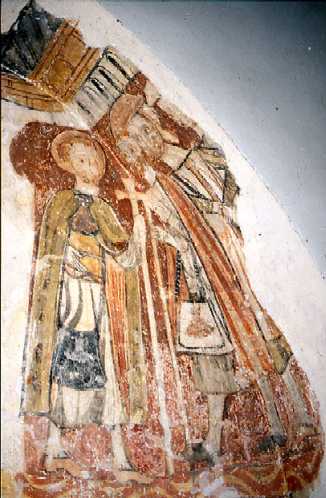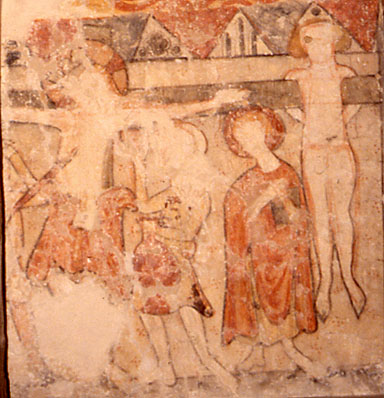Wisborough Green, West Sussex (†Chichester) 1200-1250
Crucifixion
St James with Pilgrims

The paintings are in a niche on the south side of the chancel arch wall. They are the only ones surviving at Wisborough Green, and both have unusual features.
Above, (photo left) St James the Great stands in the centre. He has a halo and a long pilgrim’s staff with a cross. His green cloak is clasped at the throat with a fastening in the form of a large scallop shell, his emblem, and around his waist is slung a pilgrim’s satchel with another scallop shell (there were once two more) on it. In his left hand he holds a book.
At the far left is a fragment of a figure of Christ, identifiable by his tripartite halo and also holding a cross-staff, while at the top between these two figures is a fragment of illusionistic brickwork.

In fact the whole background, including the right-hand soffit of the arch, is painted to give the appearance of a church. At the apex of the arch and visible in the photograph below right is an illusionistic (interior) church roof. The dark area at the ‘top’ represents the roof itself, with some ribbed vaulting. Below this are two ranges of windows and below them a group of pilgrims (originally three, now reduced effectively to two) being greeted by St James. The first of the three has a plain staff and a satchel ornamented with a scallop-shell over his arm. The second, holding a staff in front of him, wears a pilgrim’s hat. The Church’s approval and encouragement of pilgrimage could hardly be more clearly expressed.

Below the feet of St James and the pilgrim is a band of wavy ornament, and below that some illusionistic architecture making a background to the paintings below. Three triangular gables are visible, all with windows – on the left quatrefoils, in the centre narrow lancets, and on the right, mainly obscured, round (photo, right). Below these, a very unusual Cross in grey is painted on a whitish ground.
Christ, wearing a knee-length red loincloth is fastened to the Cross at the left in the standard manner, but the transverse bar of his Cross extends to the right, and one of the Thieves hangs on it, arms pinioned behind his back (or possibly fastened in front of him – it is difficult to be sure). EW Tristram¹ assumed that this must be the Penitent Thief, who was assured of his place in Paradise [Luke 23:39-43], and the sharing of the Cross-bar seems to confirm this – the Thief’s placing at Christ’s left, rather than the more ‘honourable’ right was probably dictated by considerations of space. A youthful St John stands beside the Thief, next to Stephaton with a sponge and a large red ewer (his face according to Tristram was originally ‘a hideous caricature’), and at the extreme left, Longinus gives Christ the death-blow with his lance, and raises his hand to his newly-sighted eye.
This Crucifixion also has another very unusual feature in that the crucified Christ is wearing a crown. This, I suspect, was intended to give an extra, and specific, moral dimension – the man crucified in Jerusalem may have been just another itinerant prophet – an ‘inglorious man’, as John Donne has it (see the Warning to Swearers/Sabbath Breakers), but humankind’s daily persistence in sin repeatedly re-enacts the Crucifixion of the revealed King of Glory. There might once have been a subsidiary altar below this painting, but in any event it faces the assembled worshippers in the nave directly, and that is probably deliberate.
Other early and remarkable paintings in Sussex, such as those at Hardham, have received a good deal of attention from modern writers, thus overshadowing these at Wisborough Green. But this very idiosyncratic and quite possibly unique treatment of the Crucifixion ought to be better known.
Website for St Peter ad Vincula, Wisborough Green
¹ Tristram II, p. 625